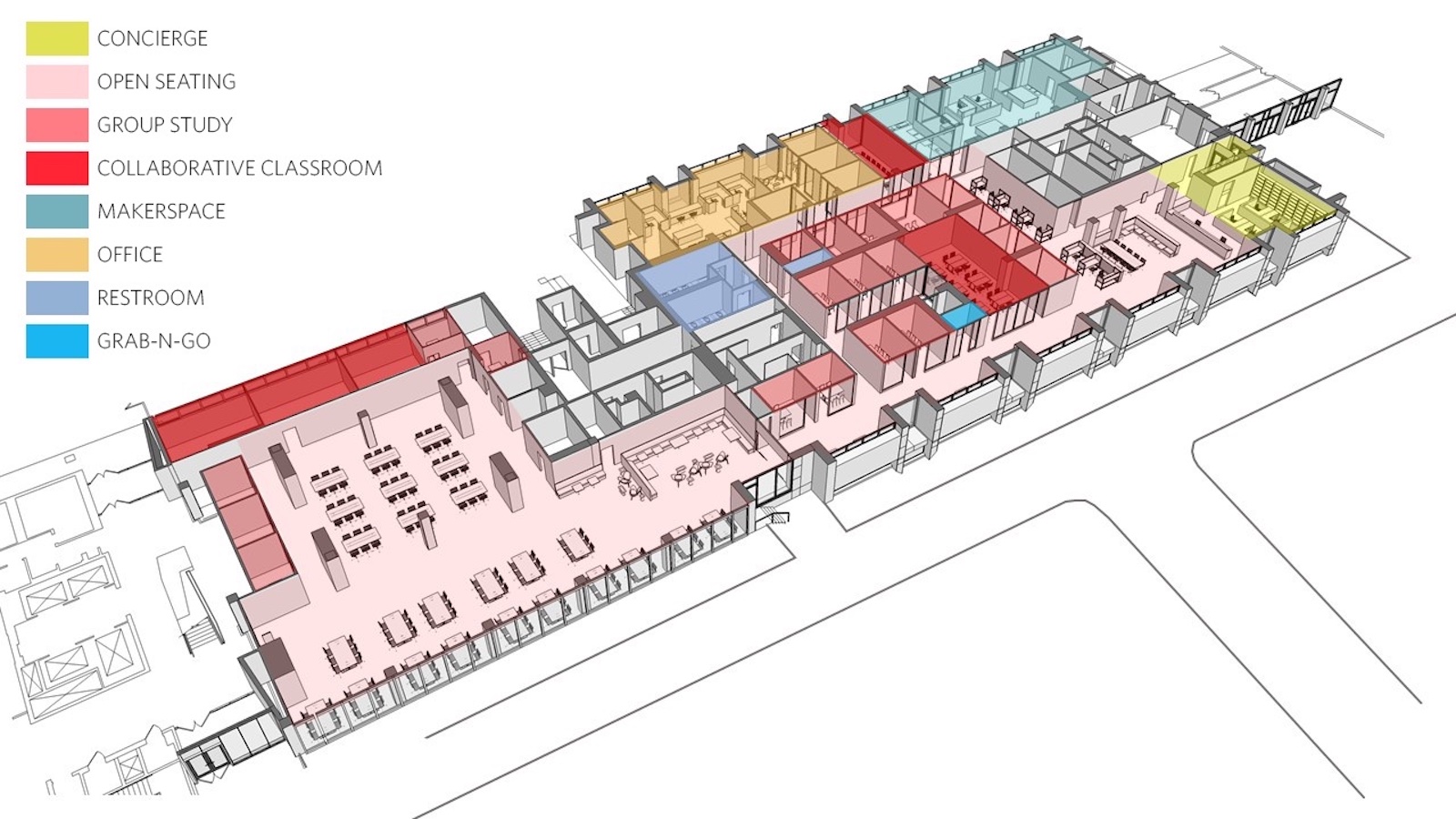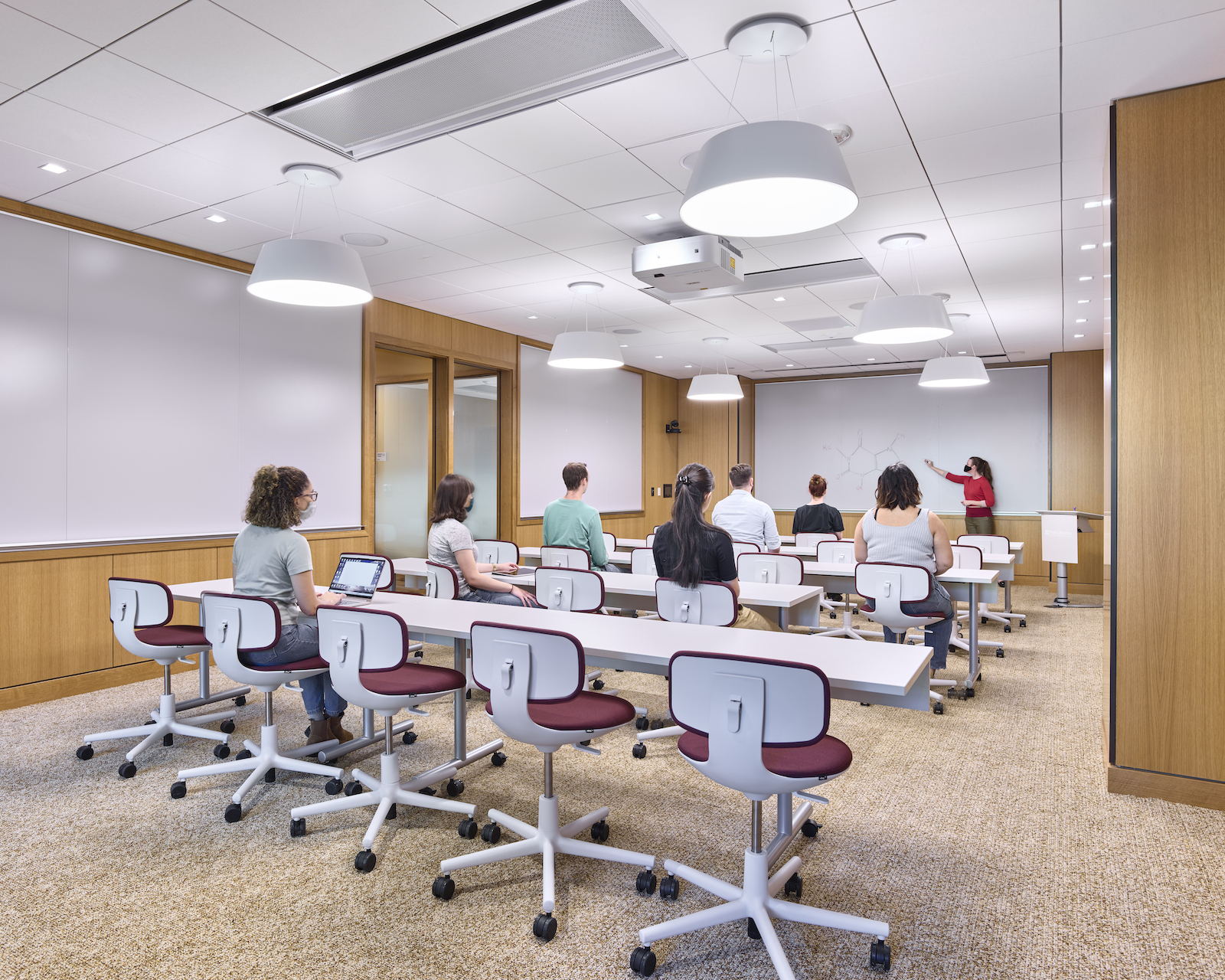The University of Pennsylvania’s Biomedical Library was built on the southern portion of the school’s campus in Philadelphia in the late 1960s. Much has changed in the ensuing decades: Penn has expanded and transformed that part of its campus with research and clinically focused buildings. And digitization has altered the function and purpose of libraries in general to where they are less about being repositories of past knowledge and more about contributing to a dynamic future.
On September 20, 2021, Penn reopened its renovated and expanded library as an open center for cross-disciplinary learning, prototyping, and collaboration. Now called Biotech Commons, the 17,000-sf building supports new modes of research by offering a range of spaces and services—from conference centers to fabrication shops—that is free to be scheduled by any student or faculty member.
“No place is as interdisciplinary as a library space, and the reimagined Biotech Commons takes this to the next level,” Constantia Constantinou, the H. Carton Rogers III Vice Provost and Director of the Penn Libraries, told Penn Today. She predicted that the facility “will enhance the intellectual vitality of Penn as a whole by providing an extraordinary user experience for all.”
The Biotech Commons unites the medical and scientific campus to the north and the core campus to the south, said the university in a statement it sent to BD+C in early January. “It is intended to provide a high-tech, community-building hub that integrates resources and brings together students, faculty, researchers, and staff from multiple disciplines.” The Biotech Commons also serves as “a powerful magnet” for communities from across campus.

“The facility is very clearly research oriented, and the research is more technologically advanced,” observes Daniela Voith, FAIA, LEED AP BD+C, IIDA, Founding Partner and Director of Design with Voith & Mactavish Architects (VMA), the design architect on the Biotech Commons renovation, which began in December 2020. Voith says that Associate Principal Sennah Loftus, VMA’s project manager, is this firm’s go-to person when it comes to integrating high-level technology into its academic facility designs.
The Judith and William Bollinger Digital Fabrication Lab within Biotech Commons is equipped with nine high-end 3D printers and two 3D scanners, a laser cutter, and plotters for scientific poster printing. The first-of-its-kind anatomy visualization system, called an Anatomage Table, is available for use by all members of the Penn community, allowing for the virtual dissection and review of life-size virtual cadavers outside of clinical lab coursework.
At the heart of Biotech Commons are clusters of adaptable group workspaces. Accommodating anywhere from four to 12 people, these allow students to have impromptu breakout sessions and meetings. A spacious, natural-light-filled reading room offers places for individual study. Various seating options encourage different formats of collaboration, and 20 group study rooms accommodate eight people each. The group studies are acoustically treated, allowing students to work together freely without disrupting others.
The reading room doubles as a multipurpose event space with moveable furniture; a Design Thinking Studio has wall-mounted whiteboards, supplies, and mobile, writable tables; and a Mixed Reality Lab is where faculty and students experiment with virtual and augmented reality. A conference room showcases the libraries’ historic collections. And the flexibly furnished Gershwind & Bennett Family Collaboration Classroom hosts seminars, lecture-style presentations, and active, flipped-classroom style instruction.
Most of the books in the library remained in the stacks on the lower levels, which were outside the renovation area.
Bureaucratic Stalling at the university level
The building team on this $11.5 million project included Wolfe Scott Associates (CM), Burns Engineering, and KMK Consulting (AV/IT). Voith says that about half of what is now Biotech Commons was renovated, and the other half had been used previously as shelf space for Stemmler Hall of the university’s Perelman School of Medicine. The library’s renovation had to be planned around sensitive lab space that included a basement which hosts Zebrafish aquariums with very low tolerances for sound vibration.

Before VMA came on board for this project, Penn Libraries—that oversees a network of 17 campus buildings—had conducted a feasibility study for the Biomedical Library renovation. VMA proposed several changes, including a new main entrance. Several master plans were bandied about to give the medical school, which is part of this complex, a better entrance, too. However, these changes would have put the project between $5 million and $6 million over budget, says Voith. It took another year to come up with an alternative plan that everyone agreed on.
Related Stories
| Sep 19, 2013
6 emerging energy-management glazing technologies
Phase-change materials, electrochromic glass, and building-integrated PVs are among the breakthrough glazing technologies that are taking energy performance to a new level.
| Sep 19, 2013
Roof renovation tips: Making the choice between overlayment and tear-off
When embarking upon a roofing renovation project, one of the first decisions for the Building Team is whether to tear off and replace the existing roof or to overlay the new roof right on top of the old one. Roofing experts offer guidance on making this assessment.
| Sep 11, 2013
BUILDINGChicago eShow Daily – Day 3 coverage
Day 3 coverage of the BUILDINGChicago/Greening the Heartland conference and expo, taking place this week at the Holiday Inn Chicago Mart Plaza.
| Sep 10, 2013
BUILDINGChicago eShow Daily – Day 2 coverage
The BD+C editorial team brings you this real-time coverage of day 2 of the BUILDINGChicago/Greening the Heartland conference and expo taking place this week at the Holiday Inn Chicago Mart Plaza.
| Sep 4, 2013
Smart building technology: Talking results at the BUILDINGChicago/ Greening the Heartland show
Recent advancements in technology are allowing owners to connect with facilities as never before, leveraging existing automation systems to achieve cost-effective energy improvements. This BUILDINGChicago presentation will feature Procter & Gamble’s smart building management program.
| Aug 30, 2013
Modular classrooms gaining strength with school boards
With budget, space needs, and speed-to-market pressures bearing down on school districts, modular classroom assemblies are often a go-to solution.
| Aug 26, 2013
What you missed last week: Architecture billings up again; record year for hotel renovations; nation's most expensive real estate markets
BD+C's roundup of the top construction market news for the week of August 18 includes the latest architecture billings index from AIA and a BOMA study on the nation's most and least expensive commercial real estate markets.
| Aug 22, 2013
Energy-efficient glazing technology [AIA Course]
This course discuses the latest technological advances in glazing, which make possible ever more efficient enclosures with ever greater glazed area.
| Aug 14, 2013
Green Building Report [2013 Giants 300 Report]
Building Design+Construction's rankings of the nation's largest green design and construction firms.
| Jul 29, 2013
2013 Giants 300 Report
The editors of Building Design+Construction magazine present the findings of the annual Giants 300 Report, which ranks the leading firms in the AEC industry.

















